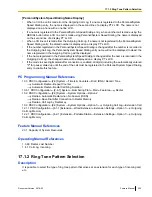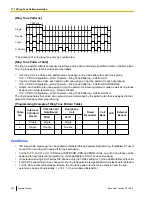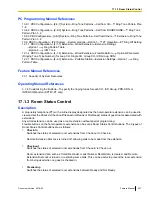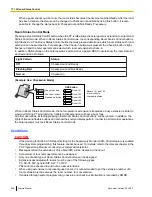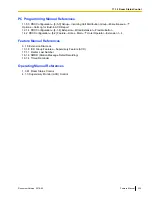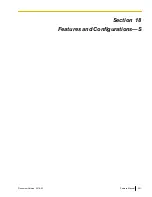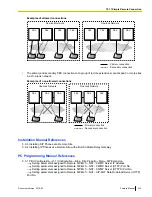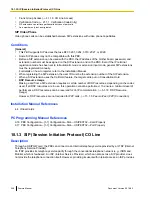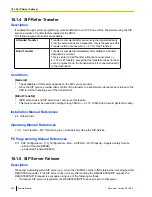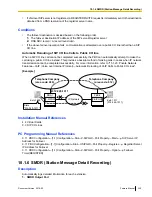
18.1 S
18.1.1 Simple Remote Connection
Description
Using the Built-in Media Relay Gateway
Using the Built-in Media Relay Gateway feature, KX-NT500 series IP-PTs, Panasonic IP-Softphones and
KX-NS0154 IP-CSs can be connected to a remote location without an additional device, such as an SBC
(Session Border Controller). These devices can be registered to the remote location after configuring the
Built-in Media Relay Gateway. For the KX-NS1000, KX-UT-series SIP phones and general SIP phones can
also be installed to the remote location easily. KX-UT SIP series phones and general SIP phones can be
connected to the Built-in Media Relay Gateway by following the method for using an SBC.
Note
•
Peer-to-peer communication is not supported for the built-in media relay gateway.
Using an SBC (Session Border Controller)
KX-UT SIP phones and general SIP phones support simple remote connectivity when the KX-NS1000 is
networked with an SBC (session border controller). Simple remote connectivity means that even if the SIP
phone is located behind a NAT router, firewall, or both, specialized settings such as NAT traversal settings do
not need to be configured for each remote extension.
There are 2 scenarios for configuring and connecting a SIP phone:
a.
The SIP phone is connected and registered to the PBX on the PBX’s local network. The necessary settings
are configured automatically by the PBX.
b.
The remote IP settings of the SIP phone are configured without first connecting the phone to the PBX.
Once programmed, the SIP phone is sent to the remote location, connected to the network and will
automatically connect to the PBX.
Conditions
•
Extensions that will be configured remotely use HTTPS for transferring the configuration file. However, a
maximum of 20 extensions per site can be connected in this way.
•
The following types of settings must be configured on the PBX:
–
The remote setting for the SIP phone’s port
–
The outside-facing IP address and port of the PBX-side network gateway
–
The necessary NAT traversal settings for the NAT device
•
The following types of setting must be configured on the PBX-side network gateway:
When using an SBC (Session Border Controller)
–
Static port forwarding settings for traversing the SBC (SIP, TR-069, RTP, and NTP)
When using the built-in Media Relay Gateway
–
Static port forwarding settings for traversing the built-in Media Relay Gateway (SIP, TR-069, RTP, NTP,
PTAP, MGCP, and FTP)
•
General SIP phones must support early media.
[Automatic Rerouting to Secondary PBX]
•
For any group of remote extensions, the primary and secondary PBX connections must be kept between
2 sites in a One-look network.
342
Feature Manual
Document Version 2016-03
18.1.1 Simple Remote Connection
Summary of Contents for KX-NS1000
Page 15: ...Section 1 For Your Safety Document Version 2016 03 Feature Manual 15...
Page 18: ...18 Feature Manual Document Version 2016 03 1 1 1 For Your Safety...
Page 19: ...Section 2 Features and Configurations A Document Version 2016 03 Feature Manual 19...
Page 36: ...36 Feature Manual Document Version 2016 03 2 1 8 Automatic Time Adjustment...
Page 37: ...Section 3 Features and Configurations B Document Version 2016 03 Feature Manual 37...
Page 44: ...44 Feature Manual Document Version 2016 03 3 1 2 BGM Background Music...
Page 45: ...Section 4 Features and Configurations C Document Version 2016 03 Feature Manual 45...
Page 89: ...Section 5 Features and Configurations D Document Version 2016 03 Feature Manual 89...
Page 122: ...122 Feature Manual Document Version 2016 03 5 1 18 DSP Resource Usage...
Page 123: ...Section 6 Features and Configurations E Document Version 2016 03 Feature Manual 123...
Page 137: ...Section 7 Features and Configurations F Document Version 2016 03 Feature Manual 137...
Page 159: ...Section 8 Features and Configurations G Document Version 2016 03 Feature Manual 159...
Page 165: ...Section 9 Features and Configurations H Document Version 2016 03 Feature Manual 165...
Page 172: ...172 Feature Manual Document Version 2016 03 9 1 6 Hot Line...
Page 173: ...Section 10 Features and Configurations I Document Version 2016 03 Feature Manual 173...
Page 217: ...Section 11 Features and Configurations K Document Version 2016 03 Feature Manual 217...
Page 220: ...220 Feature Manual Document Version 2016 03 11 1 1 KX UT Series SIP Phones...
Page 221: ...Section 12 Features and Configurations L Document Version 2016 03 Feature Manual 221...
Page 228: ...228 Feature Manual Document Version 2016 03 12 1 4 Local Alarm Information...
Page 229: ...Section 13 Features and Configurations M Document Version 2016 03 Feature Manual 229...
Page 237: ...Section 14 Features and Configurations O Document Version 2016 03 Feature Manual 237...
Page 252: ...252 Feature Manual Document Version 2016 03 14 1 9 Operator Features...
Page 253: ...Section 15 Features and Configurations P Document Version 2016 03 Feature Manual 253...
Page 331: ...Section 16 Features and Configurations Q Document Version 2016 03 Feature Manual 331...
Page 333: ...Section 17 Features and Configurations R Document Version 2016 03 Feature Manual 333...
Page 340: ...340 Feature Manual Document Version 2016 03 17 1 3 Room Status Control...
Page 341: ...Section 18 Features and Configurations S Document Version 2016 03 Feature Manual 341...
Page 364: ...364 Feature Manual Document Version 2016 03 18 1 12 Syslog Record Management...
Page 365: ...Section 19 Features and Configurations T Document Version 2016 03 Feature Manual 365...
Page 385: ...Section 20 Features and Configurations U Document Version 2016 03 Feature Manual 385...
Page 443: ...Section 21 Features and Configurations V Document Version 2016 03 Feature Manual 443...
Page 448: ...448 Feature Manual Document Version 2016 03 21 1 2 Virtual PS...
Page 449: ...Section 22 Features and Configurations W Document Version 2016 03 Feature Manual 449...
Page 459: ...Section 23 Appendix Document Version 2016 03 Feature Manual 459...
Page 481: ...Document Version 2016 03 Feature Manual 481 Notes...








